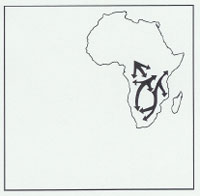 |
|
Lesson Title: West Africa
Name: Amy Smith
Discipline: History
School: Wilde Lake High School
Grade Level: High School
I. Conceptual Framework
Big Idea: Identity
Rationale:
Why are the big idea and topics important for my students to learn? Identity is an important idea for my students to learn about because it reveals distinguishing cultural traits. Identity is who people are. Identity is also about recognition of a person or thing. Using identity to teach the politics, religion, social structure and economics of West Africa will portray that cultural characteristics adapt to outside influences in order to survive, but at the same time show continuity of the past.Essential Question:
How can major world developments shape a region’s identity?Key Concepts:
- ways of life
- political structures
- economics
- art forms
- architecture
- social structure/gender/class
State and Local Standards
- Identify and evaluate the spread of Islam throughout the Middle East, North and West Africa, and southwest Europe. (951.08) PNW-1-A-1
- Describe the geographic, economic, and ethnic factors that contributed to the development of African culture. (951.09) G-2-A-3, PNW-1-A-1
- Identify the contributions of the kingdoms of West Africa. (951.10) PS-1-A-2
- Describe how the trans-Saharan trade routes linked the culture and economics of the West African kingdoms with those of North Africa and the Middle East. (951.11) G-2-A
II. Topics: (Note: Each topic is a lesson…see below)
- Diversity of Africa
- History of Africa
- Spread of Islam in West Africa
- Gold and Salt Trade Routes
- Ibn Battuta
- Epic of Sundiata
- Artistic Expressions of West Africa
III. Artworks
IV. Lessons
Lesson 1: An Overview of Africa
Lesson 2: Constructing a Timeline of African History
To understand the history of a country or region is crucial in understanding its past, present, and future. Students will construct a timeline of African history in order to become familiar with key historical periods of the continent. This history will become the foundation of our unit on West African civilizations.Lesson 3: Spread of Islam in West Africa
Lesson 4: Gold and Salt Trade Routes
Lesson 5: Ibn Battuta
Lesson 6: Epic of Sundiata
Lesson 7: Artistic Expressions of West Africa
Lesson Plan on the History of Africa, Lesson 2
Title: Constructing a Timeline of African History
Grade Level: Middle School or High-School
Length of Lesson: One 50-minute class period
Objectives:
- Students will describe eight key periods in African history.
- Students will analyze how Africa’s historical periods illustrate influences in African history and identity.
Selected Key Periods in African History:
- Bantu Migrations (c. 500 B.C.E. – 1500 C.E.)
- Rise of Islam (c. 650 – 1000)
- West African Trading Empires (c. 800 – 1600)
- Swahili Trading States (c. 1200- 1500)
- Turkish Empire (c. 1500 – 1918)
- Slave Trade (c. 1600 – 1880s)
- European Colonialism (1880s – 1960s)
- African Independence (1957 – present)
Assessing Prior Knowledge
Questions: Think/pair/share on major time periods in African history.
Do students know the names of any African civilizations or historical
periods? Can students make a list of all the countries in Africa that
they know or have heard about? Could students draw a mental map of Africa
and write the names of countries in their approximate location?
Procedure of Lesson
Students will be divided in mixed-ability pairs and will be told they
will learn about key historical periods in African history. Students will
then cut out their map cards, titles, and descriptions of periods, review
the cards, and match the maps with the corresponding period titles and
descriptions. When pairs have finished, they will organize the map cards
in chronological order and affix them to their timeline. After students
have completed the task, I will review the eight historical periods on
the overhead and hold a class discussion to analyze how they illustrate
various influences in African history.
Wrap-Up
After holding the class discussion from student-generated topics, I will
pose six questions about the activity and post them on the board. Students
will then be instructed to choose two questions to write about on a sheet
of paper. At the end of class, and after students have had time to write
their answers independently, I will choose one question to discuss for
the remaining time in class. I will be sure to tie in the lesson with
tomorrow’s topic on the spread of Islam in Africa. Students will
turn in their assignment as they leave the classroom.
Student Assessment
Questions students may write about and discuss:
- In which regions- north, west, east, or south- were key historical African empires?
- In which regions did Islam have its greatest influence?
- Based on the timeline and the period map, did the migration of Bantu-speaking peoples take place quickly or gradually?
- When did western influence begin in Africa?
- How long was the European colonial period?
- How might indigenous, Islamic, and western influences interact or conflict?
Sources:
- Teachers’ Curriculum Institute, History Alive!, Palo Alto, California. 1996. Online at http://www.teachtci.com.